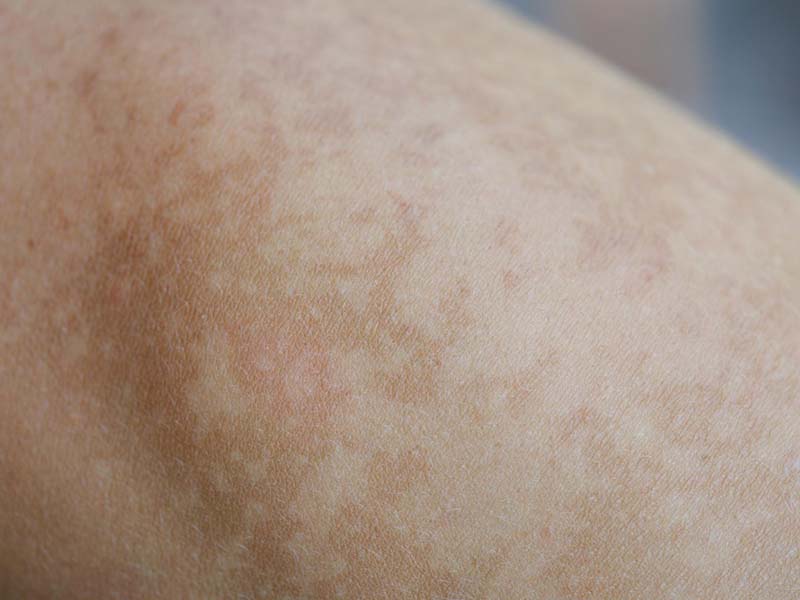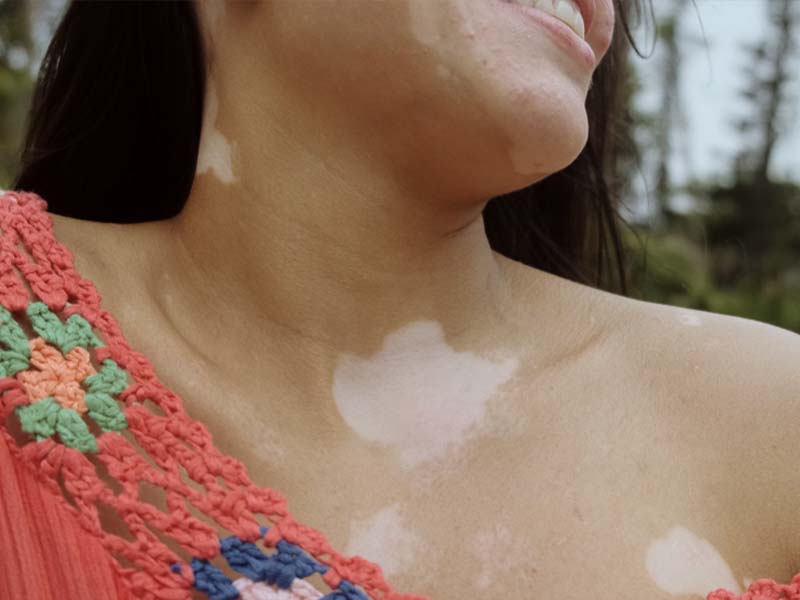Vitiligo is a skin condition that affects millions of people worldwide, characterized by the loss of pigment in the skin, resulting in white patches or spots. This condition can occur in individuals of any age, race, or gender and is thought to be an autoimmune disorder where the immune system mistakenly attacks and destroys melanocytes. The symptoms of vitiligo can vary from person to person, with the most common symptom being the loss of pigmentation in the skin, which can lead to patches that are lighter than the surrounding skin. Although vitiligo is not contagious and does not cause any physical harm, it can have significant emotional impacts, causing self-consciousness, anxiety, and depression. This article explores the causes, symptoms, and emotional impacts of vitiligo, as well as the treatments available to manage the condition.
What is Vitiligo?
Vitiligo is a skin condition that is characterized by the loss of pigment in the skin, resulting in white patches or spots. The condition can affect any part of the body, and it can occur in people of all ages, races, and genders. Vitiligo occurs when the cells that produce melanin, the pigment that gives color to the skin, hair, and eyes, are destroyed. The exact cause of vitiligo is not yet fully understood, but it is thought to be an autoimmune disorder in which the immune system mistakenly attacks and destroys melanocytes. Vitiligo can be a distressing condition for those who have it, as it can have a significant impact on a person’s appearance and self-esteem. However, it is important to note that vitiligo is not contagious, and it does not cause any physical harm or increase the risk of skin cancer.

Vitiligo Symptoms
Vitiligo is a skin condition that can cause white patches or spots on the skin. The symptoms of vitiligo can vary from person to person, and the severity of the condition can also vary. Here are some common symptoms of vitiligo:
- Depigmentation: The most common symptom of vitiligo is the loss of pigmentation in the skin, which can cause white patches or spots to appear on the skin, which can vary in size and shape. This loss of pigmentation can result in patches that are lighter than the surrounding skin and can be more noticeable in individuals with darker skin tones.
- Symmetrical patches: Vitiligo often affects both sides of the body equally, meaning that if a patch appears on one side of the body, a similar patch will likely appear on the other side. This symmetrical pattern of vitiligo is a hallmark feature of the condition, and can help to distinguish it from other skin diseases that can cause depigmentation.
- Slow progression: Vitiligo can develop slowly over time, with new patches appearing gradually over months or even years. The slow progression of vitiligo can make it difficult to predict how the condition will progress and can make it challenging to develop effective treatment plans.
- Discoloration of hair and eyes: In addition to affecting the skin, vitiligo can also cause the hair and eyes to lose color. This can result in white or gray hairs, and in rare cases, can cause a change in the color of the eyes. The loss of pigment in the eyes can cause a condition called uveitis, which can result in eye inflammation and vision problems.
- Sun sensitivity: People with vitiligo may be more sensitive to the sun, as the white patches have less melanin to protect the skin from UV rays. This can lead to an increased risk of sunburn and can make it even more important for individuals with vitiligo to use sun protection when spending time outdoors.
- Emotional impact: Vitiligo can have a significant impact on a person’s emotional well-being, as the visible symptoms can cause self-consciousness, anxiety, and depression. The emotional impact of vitiligo can be particularly severe in individuals with widespread or visible depigmentation and can require supportive care and psychological interventions in addition to medical treatment.

Loss of Pigment in Skin
Loss of pigment in the skin is the primary characteristic of vitiligo. In this condition, the melanocytes, which are the cells responsible for producing pigment in the skin, are destroyed, leading to depigmentation or white patches on the skin. The loss of pigment can occur anywhere on the body, but it is most commonly seen on the face, hands, arms, and feet.
The loss of pigment can also affect other areas of the body, including the eyes, mouth, and hair. The extent and severity of the loss of pigment can vary widely among individuals, with some experiencing only a few small white patches. In contrast, others may have extensive areas of depigmentation.

The loss of pigment in the skin can have significant psychological and emotional effects, leading to decreased self-esteem and feelings of self-consciousness, especially in individuals with visible white patches on the face or other prominent areas of the body.
If you notice any of these symptoms, it is important to speak with a healthcare provider or dermatologist to determine if you have vitiligo. While there is no cure for vitiligo, there are treatments available that can help to manage the symptoms and improve the appearance of the skin. It is important to seek treatment to manage the emotional impact of vitiligo and prevent potential complications.
Causes of Vitiligo
The exact cause of vitiligo is not yet fully understood, but it is thought to be an autoimmune disorder in which the immune system mistakenly attacks and destroys melanocytes, the cells that produce melanin. However, there are several factors that may contribute to the development of vitiligo. Here are some of the possible causes of vitiligo:
- Genetics: Research has shown that vitiligo can run in families, suggesting that there may be a genetic component to the condition. However, not all cases of vitiligo are inherited, and the condition can also occur in individuals with no family history.
- Autoimmune disorder: Vitiligo is often considered an autoimmune disorder, meaning that the immune system mistakenly attacks and destroys the melanocytes, the cells that produce melanin. It is not yet clear why the immune system does this, but it is thought that genetic and environmental factors may play a role.
- Neurogenic factors: Some researchers believe that vitiligo may be caused by changes in the nervous system, which can affect the function of the melanocytes. These changes may be triggered by trauma, injury, or exposure to certain toxins.
- Environmental factors: Exposure to certain environmental factors may increase the risk of developing vitiligo, including exposure to chemicals, sunburns, and emotional stress. However, it is important to note that not everyone who is exposed to these factors will develop vitiligo.
- Inflammatory conditions: People with certain inflammatory conditions, such as psoriasis and alopecia areata, may be at an increased risk of developing vitiligo. This is thought to be due to the shared underlying immune system abnormalities.
- Viral infections: Some researchers believe that certain viral infections may trigger the onset of vitiligo in people who are genetically susceptible. However, more research is needed to fully understand the link between viral infections and vitiligo.
- Oxidative stress: Oxidative stress occurs when there is an imbalance between the production of reactive oxygen species and the body’s ability to neutralize them. Some researchers believe that oxidative stress may play a role in the development of vitiligo, as it can damage melanocytes and reduce melanin production.

It is important to note that while these factors may increase the risk of developing vitiligo, they do not guarantee that a person will develop the condition. The exact cause of vitiligo is complex and may involve a combination of factors. If you are concerned about your risk of developing vitiligo, speak with a healthcare provider or skin dermatologist to discuss your options for prevention and management.
Vitiligo Treatment
While there is currently no cure for vitiligo, there are several treatment options available that can help to manage the symptoms and improve the appearance of the skin. Here are some of the most common treatments for vitiligo:
- Topical corticosteroids: These creams and ointments contain steroids that can help to reduce inflammation and lighten the skin. Topical corticosteroids are most effective on small areas of skin, and long-term use can cause thinning of the skin and other side effects. They can also be combined with other treatments for better results.
- Topical calcineurin inhibitors: These medications, such as tacrolimus and pimecrolimus, are applied to the skin and can help to reduce inflammation and re-pigment the skin. Topical calcineurin inhibitors are less likely to cause skin thinning than corticosteroids, but they can cause a burning sensation and other side effects. They are frequently used coupled with other forms of treatment.
- Psoralen plus ultraviolet A (PUVA) therapy: This treatment involves taking psoralen, a medication that makes the skin more sensitive to light, and then exposing the skin to ultraviolet A (UVA) light. PUVA therapy can help to re-pigment the skin, but it can also increase the risk of skin cancer and other side effects. It is typically used for extensive or stubborn cases of vitiligo.
- Narrowband ultraviolet B (NB-UVB) therapy: This treatment involves exposing the skin to narrowband UVB light, which can help to re-pigment the skin without the use of psoralen. NB-UVB therapy is generally safe and well-tolerated, but it may require several sessions before results are seen. It is often used for localized areas of vitiligo.
- Excimer laser: This treatment uses a particular type of laser to re-pigment the skin. Excimer laser therapy is most effective on small areas of skin, and it may require several sessions before results are seen. It is often used for small and the stubborn regions of vitiligo.
- Skin grafting: In severe cases of vitiligo, skin grafting may be necessary to re-pigment the affected areas. This involves taking skin from one part of the body and transplanting it to the affected area. Skin grafting is generally only used in cases where other treatments have not been effective and are most effective for stable vitiligo.

It is important to note that not all treatments work for everyone, and it may take some trial and error to find the best treatment for each individual. Additionally, some treatments may not be suitable for certain individuals, such as pregnant women or people with a history of skin cancer. It is important to speak with a healthcare provider or dermatologist to discuss the best treatment options for your individual needs.
Final Thoughts
Vitiligo is a skin condition that can affect anyone, regardless of their age, race, or gender. It is a distressing condition that can have a significant emotional impact on individuals due to its effect on their appearance and self-esteem. The symptoms of vitiligo can vary from person to person, with the most common symptom being the loss of pigmentation in the skin, resulting in white patches or spots.

It is important to seek medical attention if you notice any symptoms of vitiligo, such as white patches or spots on your skin, as early diagnosis and treatment can help manage the emotional impact of the condition and prevent potential complications. Remotederm provides a convenient and accessible online dermatology consultation platform that allows individuals to get a diagnosis and treatment plan from the comfort of their homes. It is essential to seek treatment to manage the emotional impact of vitiligo and prevent potential complications. Remember, vitiligo is not contagious and does not cause any physical harm.
FAQs
1. How does vitiligo affect a person emotionally?
Vitiligo can have a significant emotional impact on a person, causing self-consciousness, anxiety, and depression. The emotional impact can be particularly severe in individuals with widespread or visible depigmentation and may require supportive care and psychological interventions in addition to medical treatment.
2. Can vitiligo cause skin cancer?
No, vitiligo does not cause skin cancer. However, people with vitiligo may be more sensitive to the sun and have an increased risk of sunburn, which can increase the risk of developing skin cancer.
3. Can vitiligo lead to other health problems?
Vitiligo does not typically cause any physical harm, and it does not increase the risk of skin cancer. However, in rare cases, vitiligo can be associated with other autoimmune disorders, such as thyroid disease.
4. Can vitiligo cause eye problems?
In rare cases, vitiligo can cause eye problems such as uveitis, which can lead to eye inflammation and vision problems.
5. Can vitiligo be prevented?
Currently, there is no known way to prevent vitiligo. While there are treatments available to help manage the symptoms of vitiligo, there is no cure or prevention method at this time.
6. Is it important to seek treatment for vitiligo?
Yes, it is important to seek treatment for vitiligo to manage the emotional impact of the condition and prevent potential complications.

2 comments
HI ! My Grand daughter has developed white scars aged 5+ and it seems she has vitiligo. I would like to know how to go about it …I mean appointment and all. She is presently in India and will be here in May end.
I was looking for doctors who sees Vitiligo patients and came across DR.BAHMAN SOTOODIAN online.
Would appreciate your quick response .
Thanks & Regards,
Warmly
Patty
Hi Patty! We’re sorry to hear about your granddaughter’s possible vitiligo. As parents can consult a dermatologist on behalf of their children under 18, you can sign up on our online dermatology platform and submit her case (including description and photos) 24/7.
Our board-certified dermatologists will diagnose the condition within 12 hours and fax the prescription to your pharmacy. Our team is experienced in diagnosing and treating a wide range of skin conditions, including vitiligo.
Please don’t hesitate to use our convenient platform for her care. Thank you for considering Remotederm.